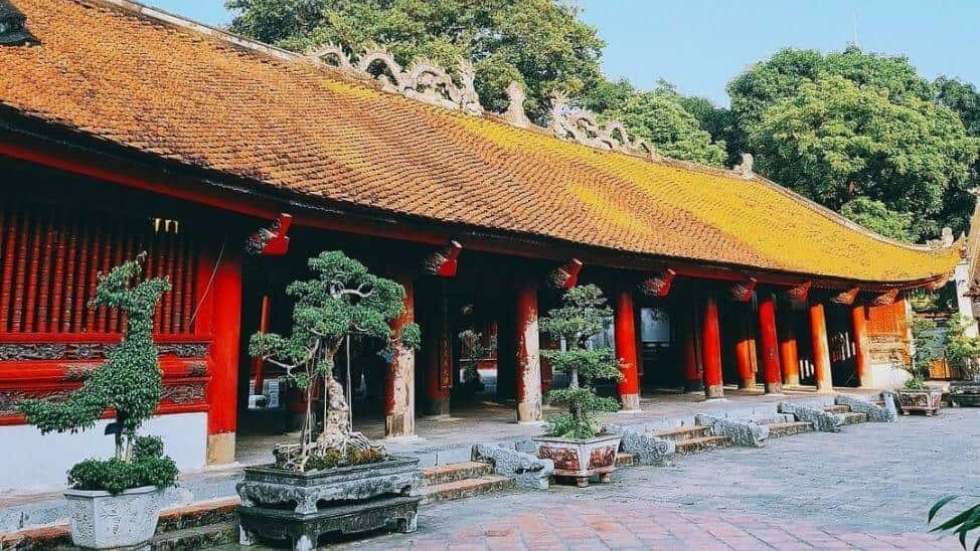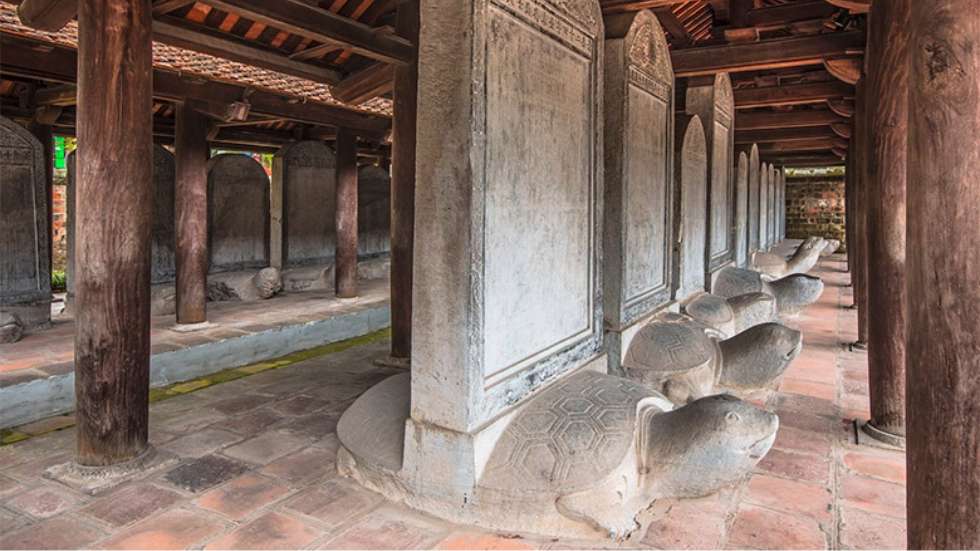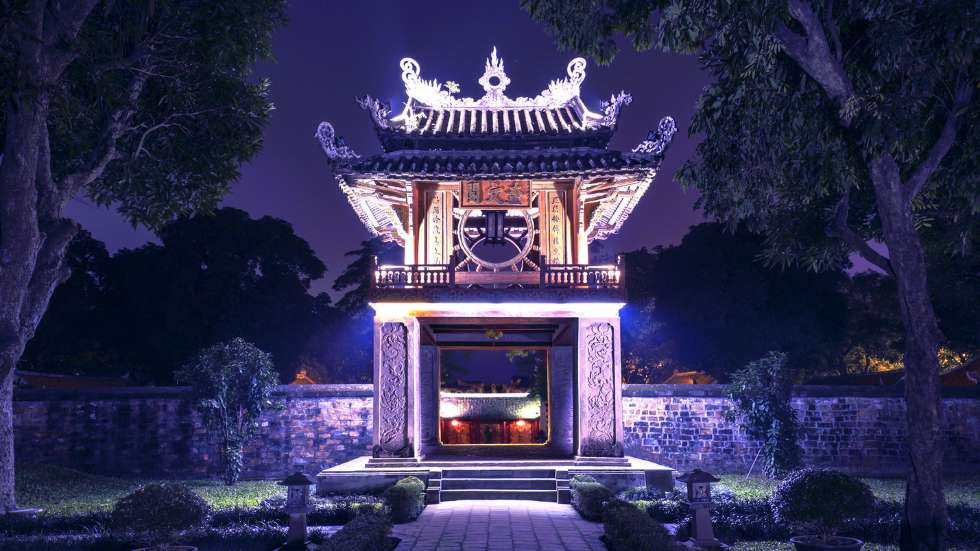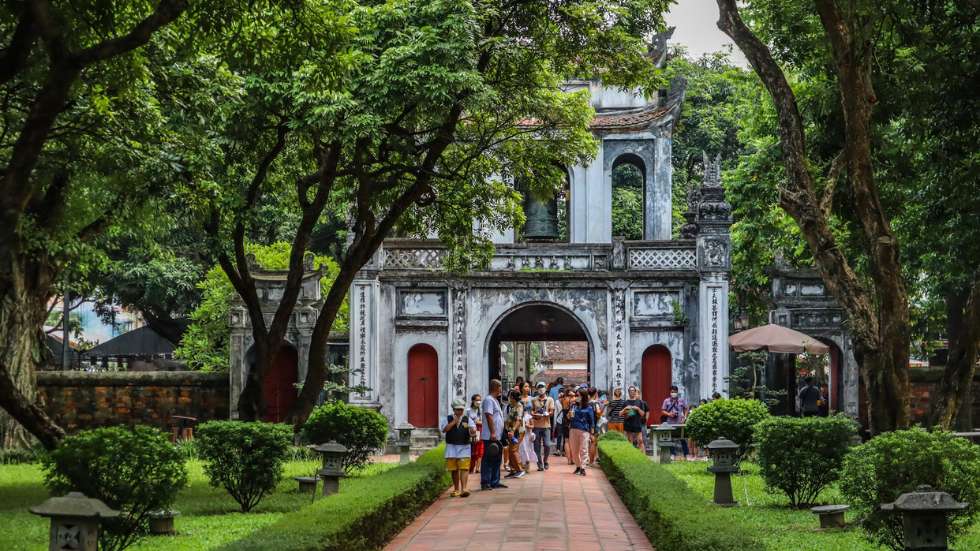LOGIN - TOURISM PROFESSIONALS
Trusted & professional DMC & Tour Operator in Vietnam
WITH A PROFESSIONAL ACCESS, YOU WILL HAVE ACCESS TO:
- Our complete production (tours, excursions and personalized modules).
- Our Toolbox (unique documents about each of our destinations that will help you in providing detailed information to your clients).
- Our highlights, recommendations, newsletters and many other practical contents.
Temple of Literature in Hanoi
The Temple of Literature in Hanoi, known locally as Văn Miếu – Quốc Tử Giám, is one of Vietnam’s most iconic cultural landmarks. Founded in the 11th century and later established as the nation’s first university, this historic sanctuary stands as a living testament to the country’s deep reverence for education, art, and tradition. Every step you take on its hallowed grounds echoes centuries of scholarly pursuit and national pride.
In addition to its profound historical significance, Văn Miếu – Quốc Tử Giám has evolved into a vibrant center for cultural events and academic ceremonies. It is here that many generations of talented individuals were nurtured, making the site a symbol of intellectual excellence and cultural heritage.
Historical Background and Cultural Significance
The Origins of The Temple of Literature in Hanoi
Constructed in the 11th century during the reign of Emperor Lý Nhân Tông, the Temple of Literature was initially established as a Confucian temple dedicated to the revered teacher, Confucius. Soon after, it was transformed into the first national university of Vietnam. This dual purpose as a place of worship and a center of learning has defined the temple’s character throughout history.
The institution has played a crucial role in shaping the intellectual landscape of Vietnam. Many generations of scholars passed through its halls, and the temple’s legacy continues to inspire those who value education and cultural heritage. The site stands as a “mirror” reflecting the spirit of learning and the enduring respect for talent and scholarship in Vietnamese society.
A Legacy of Scholarship
Văn Miếu – Quốc Tử Giám is more than a historical monument; it is a living repository of Vietnam’s academic traditions. The temple houses 82 stone steles that commemorate the achievements of successful candidates in the ancient imperial examinations. These steles, recognized by UNESCO as “World Documentary Heritage,” serve as silent testimonies to the nation’s long-standing commitment to education.
The temple also enshrines three illustrious monarchs known for their enlightened rule—Lý Thánh Tông, Lý Nhân Tông, and Lê Thánh Tông—whose images are venerated within the complex. This deep connection to the past reinforces the temple’s role as a cultural beacon, emphasizing the importance of learning and the preservation of traditional values.
.jpg)
Source: Internet
What Visitors Should Know Before Planning
For those planning a visit, here are some essential details about Văn Miếu – Quốc Tử Giám:
Address:
58 Quốc Tử Giám Street, Văn Miếu Ward, Đống Đa District, Hanoi
Opening Hours:
Daily from 8:00 AM to 5:00 PM
Ticket Prices:
- Adults: 70,000 VND
- Students, pupils, and persons with disabilities: 35,000 VND
The temple is strategically located in the Đống Đa district, nestled amid four bustling streets—Nguyễn Thái Học, Văn Miếu, Quốc Tử Giám, and Tôn Đức Thắng. Visitors should note that many of the surrounding roads are one-way, so planning your route in advance is advised.
Exploring the Architectural Splendor
The Five Inspiring Courtyards
The Temple of Literature is divided into five distinct courtyards, each representing a stage in the journey toward intellectual enlightenment.
First Courtyard: The Welcoming Space
The entrance courtyard immediately sets a tone of tranquility. With its well-tended gardens, ancient trees, and traditional pavilions, this area invites visitors to leave the bustle of the modern world behind. It symbolizes the welcoming nature of the temple, a place where visitors are encouraged to slow down and reflect.
Second Courtyard: The Courtyard of Ceremonies
In the second courtyard, you will find pavilions and colonnades adorned with intricate motifs and decorative carvings. Historically, this space was used for important ceremonies and rituals. Today, the architectural elegance of this courtyard offers a glimpse into the ceremonial traditions that once played a central role in the temple’s functions.
Third Courtyard: The Heart of the Temple
Perhaps the most famous feature of the temple is the third courtyard, where the iconic 82 stone steles are located. These steles honor scholars who achieved distinction in the imperial examinations and are a profound reminder of Vietnam’s scholarly legacy. Walking along this corridor, visitors are enveloped in the legacy of academic excellence that has shaped the nation.
Fourth Courtyard: The Reflection Space
The fourth courtyard provides a more intimate setting for contemplation. Narrow walkways and secluded corners allow for quiet reflection, inviting visitors to absorb the historical ambiance and connect with the deeper meaning behind the temple’s architecture.
Fifth Courtyard: The Culmination of Enlightenment
The final courtyard marks the culmination of the temple experience. Here, graceful arches and refined decorative elements create an atmosphere of achievement and wisdom. This space symbolizes the ultimate realization of learning and intellectual growth, leaving visitors with a lasting impression of the temple’s grandeur and timeless beauty.
Intricate Architectural Details
Every detail of the Temple of Literature has been thoughtfully crafted. The roofs, with their elegantly upturned eaves, are adorned with ceramic tiles and subtle decorative patterns. Intricately carved wooden doors and stone pillars bear motifs such as lotus blossoms and mythical creatures, each element imbued with symbolic meaning.
These artistic details are not merely ornamental; they narrate the story of Vietnam’s cultural and intellectual evolution. The harmonious blend of form and function makes the temple a true masterpiece of traditional Vietnamese architecture, celebrated for its aesthetic beauty and historical depth.

Source: Internet
The 82 Stone Steles: A Testament to Scholarship
The Legacy Etched in Stone
At the core of the temple’s cultural heritage lies the corridor of 82 stone steles. These steles, carefully carved in classical Chinese script, stand as enduring monuments to the achievements of Vietnam’s most distinguished scholars. Each stele is inscribed with the names and accomplishments of successful candidates from the imperial examinations.
The steles are more than historical records—they are symbols of the enduring value placed on education and intellectual merit. Their weathered surfaces, softened by centuries of exposure, still convey the reverence for knowledge that has defined Vietnamese culture. Walking along this corridor is a deeply moving experience, as it allows you to connect with the legacy of generations who dedicated themselves to the pursuit of learning.
A Corridor of Remembrance
The steles are arranged along a central pathway that invites quiet contemplation. As soft natural light filters through ancient trees, the inscriptions become even more poignant, casting gentle shadows on the stone. This reflective space provides visitors with the opportunity to absorb the temple’s rich history and appreciate the sacrifices and achievements of those who came before.
The corridor is often considered the emotional heart of the Temple of Literature—a place where the spirit of scholarship resonates in every carved character.

Source: Internet
The Cultural Relevance Today
A Living Legacy of Education
Although the Temple of Literature is steeped in history, its cultural significance is as vibrant today as it was centuries ago. The temple continues to serve as a symbol of national pride and the enduring importance of education in Vietnamese society. It hosts a variety of cultural events, academic ceremonies, and traditional festivals, reinforcing its role as a dynamic center of learning and cultural expression.
Students, scholars, and visitors from around the world come to the temple not only to admire its architectural beauty but also to draw inspiration from its storied past. The peaceful ambiance and timeless artistry of the temple remind us that the pursuit of knowledge is a universal value that transcends time and borders.
Experiencing the Temple by Day and Night
The experience of the Temple of Literature is profoundly influenced by the time of day. During the daylight hours, natural sunlight reveals every intricate detail of the structure, highlighting the vibrant colors of the gardens and the delicate textures of the stonework. This is an ideal time for photography and in-depth exploration.
In contrast, an evening visit transforms the temple into a mystical sanctuary. Soft, ambient lighting casts gentle shadows and creates an almost otherworldly atmosphere, perfect for quiet reflection and introspection. Whether you choose to visit by day or by night, each moment spent within the temple grounds offers a unique perspective on its cultural and historical significance.

Source: Internet
Immersing in the Surrounding Cultural Landscape
The Enchanting Gardens and Open Spaces
Surrounding the temple are meticulously landscaped gardens that enhance the serene ambiance of the site. These gardens feature ancient trees, flowering shrubs, and small water features that embody the Vietnamese philosophy of living in harmony with nature. They provide a tranquil retreat from the hustle and bustle of the city, inviting visitors to relax and enjoy the natural beauty that complements the architectural splendor of the temple.
The gardens are an integral part of the temple experience, symbolizing balance, growth, and the nurturing of the mind and spirit. A leisurely stroll through these green spaces adds another layer of depth to your visit, reinforcing the connection between nature and knowledge.
Cultural Workshops and Local Exhibitions
The area around the Temple of Literature is also a vibrant hub for traditional arts and cultural activities. Nearby workshops offer hands-on experiences in calligraphy, traditional music, and craft-making. These immersive activities allow visitors to engage directly with Vietnamese heritage and gain a deeper understanding of the skills and traditions that have been passed down through generations.
Participating in a calligraphy workshop, for instance, gives you the chance to learn the art of brush and ink—a technique that has been refined over centuries. Local exhibitions featuring traditional paintings and handicrafts further enrich your visit, making it a comprehensive cultural experience that goes beyond the static beauty of the monument.
A Cultural Corridor in the Heart of Hanoi
The Temple of Literature is ideally located in the heart of Hanoi’s Old Quarter, surrounded by numerous other cultural landmarks. Within walking distance, you can explore attractions such as Hoàn Kiếm Lake, St. Joseph’s Cathedral, and Đồng Xuân Market. This proximity creates a cultural corridor where you can experience a diverse range of historical and modern influences that define Hanoi.
Visiting multiple sites in one day allows you to appreciate the rich tapestry of Hanoi’s heritage—from ancient temples and colonial architecture to lively street markets and contemporary art galleries. Each destination adds its own unique story to your overall understanding of the city.
A Journey Through Time and Culture
The Living Tapestry of the Temple
The Temple of Literature is far more than an ancient monument—it is a living tapestry that weaves together art, education, and cultural identity. Every courtyard, stone stele, and decorative detail contributes to an overarching narrative of intellectual legacy and aesthetic beauty. The seamless integration of history and modernity creates an immersive experience that touches both the heart and mind.
Every visit to the temple is like taking a journey through time, where each step connects you with the countless scholars and artisans who have contributed to Vietnam’s cultural heritage. It is an experience that inspires deep reflection and leaves a lasting impression of the transformative power of knowledge.
Embracing the Future While Honoring the Past
As you conclude your visit to the Temple of Literature, you leave not just with memories of exquisite architecture and peaceful gardens, but with a renewed appreciation for the enduring values of education and cultural pride. The temple stands as a beacon for future generations, a reminder that while modernity marches on, the spirit of learning and the respect for tradition remain timeless.
This harmonious blend of past and present is the very essence of Hanoi—a city that continues to evolve while faithfully preserving its rich heritage. Each visit to the temple reaffirms the idea that true wisdom is ageless and that the legacy of the past enriches our future.

Source: Internet
Conclusion
In conclusion, Hanoi’s Temple of Literature is a magnificent testament to Vietnam’s rich cultural and educational heritage. Our comprehensive guide has explored its fascinating history, the inspiring layout of its five courtyards, the profound significance of its 82 stone steles, and the intricate architectural details that make it a masterpiece of Vietnamese art. We also provided essential visitor information—including its address at 58 Quốc Tử Giám Street in the Đống Đa district, opening hours from 8:00 AM to 5:00 PM daily, and affordable ticket prices.
Whether you visit during the bright light of day or the serene glow of evening, the temple offers a transformative journey through time—a place where history, nature, and art converge in perfect harmony. We warmly invite you to experience this cultural treasure for yourself and discover the timeless legacy of Vietnamese scholarship and tradition.
.jpg)
.jpg)
.jpg)
.jpg)
.jpg)
.jpg)
.jpg)
.jpg)
.png)
.jpg)
.jpg)
.jpg)
.jpg)
.jpg)
.jpg)
.jpg)
.jpg)
.jpg)
.jpg)